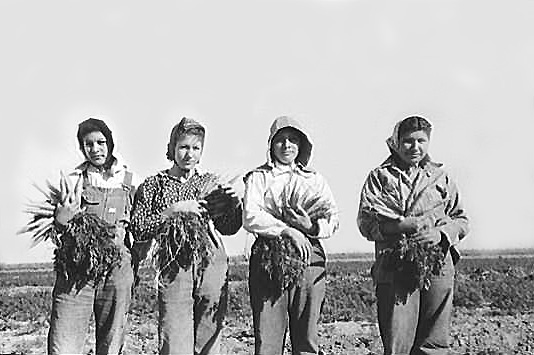
1939 "Mexican girl carrot worker"
Photograph by Russell Lee
Healthcare
Home | Education | Healthcare | History | Migratory Patterns
Law & Activism | Bibliography | Image Gallery
“Thousands of farm workers experience preventable injuries and sicknesses annually, even as they bear the burdens of U.S. consumers' groceries on their backs.” ~Colin Austin (5)

1939 "Mexican girl carrot worker"
Photograph by Russell Lee
Agricultural work has consistently ranked as one of the most dangerous occupations in the United States; however, many migrant farm workers do not have access to routine health care (6). In addition to being exposed to occupational hazards, migrant workers are subjected to overcrowded housing, unclean water, and additional unsanitary conditions (7, 8). The conditions migrant farm workers face relates to similar disadvantaged groups in this country, such as poor citizens and recent immigrants (9). The experiences of migrant workers are unique, however, due to the constant migration and occupational hazards faced by these workers.
A number of health conditions specifically affect migrant farm workers and their children. Roughly 313,000 farm workers suffer from pesticide related illnesses each year (10). Pesticide related illnesses include gastrointestinal, respiratory, ear, nose, and throat infections. Pesticide related illnesses are increased by poor hygiene and unsanitary conditions (11, 12). Farm workers often work in harsh climate conditions without access to water; this leads to heat stroke and dehydration (13). Many children experience ear, nose, throat infections as a result of direct contact with pesticides; however, there have been cases of children becoming ill because of indirect pesticide contact through touching a parent or sibling who handled or worked around pesticides (14). These findings show the importance for proper cleansing of clothes and exposed body parts after the exposure to pesticides in order to reduce the spread of disease. In addition to work related illnesses, migrant farm working women experience high rates (approximately 25%) of miscarriage or stillbirths (15, 16). There is also a high rate of premature births in women migrant farm workers (17). Both of these issues are due to the lack of prenatal care available to these women.
Migrant workers face many hardships because of their lack of health care. Illnesses and injuries create major problems for migrant families because roughly 75% of migrant workers are uninsured (18). These families cannot afford to take time off work to go to the hospital and most of the time workers cannot find transportation to the hospital or local clinic (19). Migrant workers who also have young children must find childcare, which adds to the stress of receiving medical care (20). In addition to barriers to reaching care, migrant workers also face obstacles once they reach help because many hospitals do not have interpreters or staff readily available to translate (21). All of these obstacles lead farm workers to only seek care as an emergency and often times as a last resort. This method of obtaining care eventually causes more problems because emergency room care increases cost for the patient and a more severe condition requires more invasive care (22). These numerous obstacles lead migrant workers to ignore the need to seek medical care even at the cost of a diminished health status.
Currently, few programs exist to aid migrant workers in their fight for health care coverage. The Migrant Health Act was enacted in 1962 to provide medical services to farm workers and their families; however, when California voters passed Proposition 187, also defined as an attempt to limit services like health care to citizens of the United States, health care for migrant workers was directly affected (23). Proposition 187 was eventually declared unconstitutional but the damage was already done to migrant workers receiving care. Many undocumented workers became afraid of seeking care for the fear of being turned in to immigration services (24). In addition to a lack of programs for migrant workers, government programs have also ignored the children of migrant workers. Current federal programs provide assistance to children in poverty; however, migrant workers do not have residency in the United States so their children are not able to receive federal aid for health care (25). Migrant workers generally under utilize the services that are offered by Migrant Health and Community Centers. Studies show that only 15 to 20% of migrant workers seek these federally funded sources of care (26). The lack of seeking out care by workers most likely relates, once again, to the lack of services available to migrant workers, such as transportation, childcare, and interpretive services.
All of the situations mentioned previously affect the overall health of migrant farm workers. Migrant workers battle illness, poor working environments, unsanitary living conditions, inadequate access to health care, and exposure to toxins in their daily lives. All of these factors influence the overall health of farm workers and their children. This issue must be considered in order to better the care available to migrant workers. It is important to assess the current programs available to farm workers and their families in order to better the existing services of care. Providing total comprehensive care is nearly impossible because of the seasonal patterns of migration farm workers follow; however, accessible clinics or hospitals with interpreters available for workers are important in order to provide care migrant workers are comfortable utilizing.